| Article ID | Journal | Published Year | Pages | File Type |
|---|---|---|---|---|
| 6456479 | Journal of Molecular Catalysis A: Chemical | 2017 | 7 Pages |
â¢The catalytic system is free of heavy metals and toxic solvents.â¢Castor oil epoxidation optimization has been made using methyl ricinoleate as a model.â¢Alumina catalyzes epoxidation of castor oil with H2O2 in ethyl acetate solution.â¢A characterization study has been made for castor oil epoxide.
In order to obtain monomers from vegetable source, the castor oil epoxidation process was investigated. The catalytic system used in this work, H2O2/alumina/ethyl acetate, can be considered as a green system, free of heavy metals and toxic solvents. These characteristics make the system appropriate for the purpose of this study since they increase the probabilities of obtaining a biomaterial with the desired specifications regarding toxicity. Reaction conditions of castor oil epoxidation were optimized using methyl ricinoleate as a model compound. In order to identify the operating region, it was developed an experimental design 23 with 17 assays (6 axial points and central point in triplicate) in which, methyl ricinoleate, hydrogen peroxide and catalyst initial quantities in the reaction mixture were the studied variables. The system showed great efficiency with 100% of selectivity in the methyl ricinoleate epoxide production. In optimized conditions, it showed conversion of 99% in 6Â h. It was obtained a conversion of 94%, an epoxidation percentage of 84 and a selectivity of 89% toward the epoxides for the castor oil epoxidation. These results show the efficacy of the catalytic system used in this work. Epoxidized castor oil structure was confirmed by FTIR, Raman and 1H NMR techniques.
Graphical abstractDownload high-res image (194KB)Download full-size image
